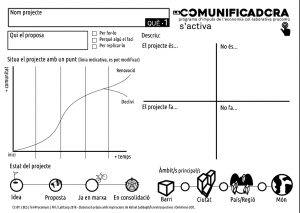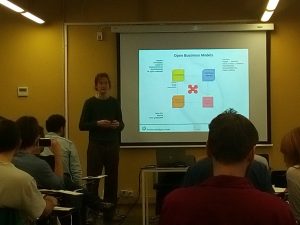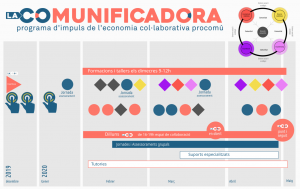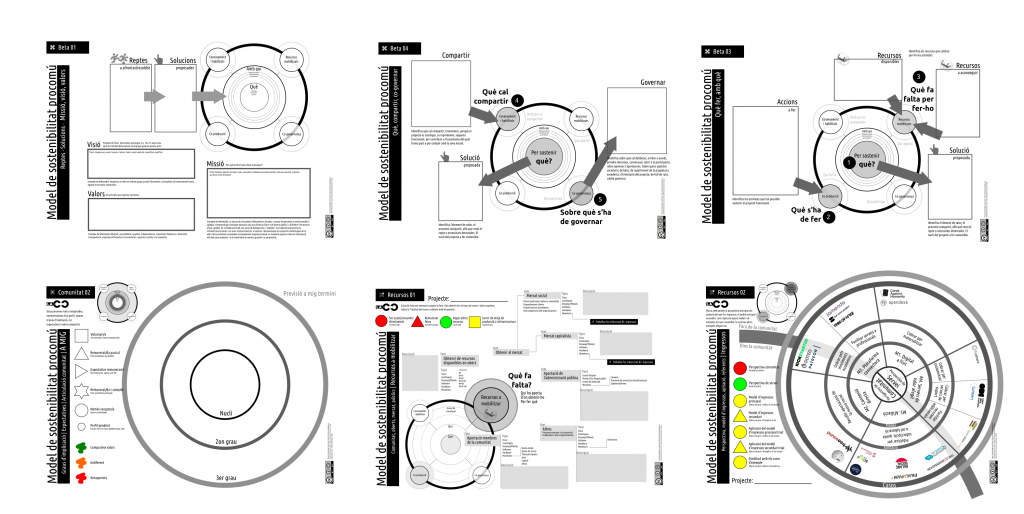This post is also available in: Español (Spanish) English
La Comunificadora, de Barcelona Activa, coordinada conjuntament amb la cooperativa LabCoop, és un programa per acompanyar la transició de projectes de l’Economia Col·laborativa a l’Economia del procomú. Es dirigeix a projectes nous o ja existents que els cal suport per funcionar en una economia social i solidària basada en els comuns, i ja ha acompanyat una cinquantena de projectes en les últimes 5 edicions.
(Descarrega les diapositives de la presentació)
(Llegeix Transitant cap al procomú – La Comunificadora)
 Un programa en tres iteracions
Un programa en tres iteracions
En la primera Iteració Beta«La Comunificadora s’activa» oberta a tothom, serveix per explicar el programa, identificar reptes i oportunitats, alhora que acompanyar i definir els projectes perquè puguin preparar les seves candidatures i entrar al programa, amb el focus posat en el procomú. Ràpidament, cada un dels projectes reflexiona i imagina com configurarà cada un dels pilars.
Els projectes seleccionats accedeixen a la segona iteració de 3 mesos. Cada un dels quals compta amb el suport d’una persona tutora del programa, acostumen a girar entorn temàtiques i propòsits molt diferents, des de projectes de banc de temps, d’habitatge, cures col·lectives, mobilitat sostenible, ràdios comunitàries,….

Aquests projectes segueixen un itinerari (26 sessions), al llarg de les quals s’utilitza com a fil conductor el Model de sostenibilitat del procomú, un model utilitzat des de la primera edició del programa.
La Comunificadora se centra en el procomú en oposició a les economies extractives, projectes, moltes vegades empreses StartUp, que no tenen un model de negoci sinó que sovint se sostenen a través de rondes de finançament, d’inversors de risc (business angels) i/o gegants oligopolístics, i que no són sostenibles, ni econòmicament ni pel medi ambient, mentre posen en risc els drets socials. No es busca replicar-les fent-ne alternatives del mercat social, perquè no són replicables i mirar de fer-ho porta directament al fracàs. El que es busca doncs és trobar models alternatius per afrontar els reptes identificats.
Les següents 5 sessions de formació, serveixen per fer una segona iteració, per aprofundir i ampliar els coneixements en cada un dels 5 pilars, amb Llenços de l’itinerari dels 5 pilars del procomú dissenyats específicament amb aquest propòsit,
• Pilar central, on es troba el Recurs Procomú. Identifica l’element de valor, el procomú compartit, allò que resol el repte o les necessitats detectades, el nucli del projecte a fer sostenible, amb la Missió, Visió i Valors, ben definits, i la comunitat (el grup de persones que gestionen i treuen profit del procomú).
• Pilar de recursos a mobilitzar, ingressos i contribucions. Identifica els recursos que caldran per fer les activitats que requereix el projecte. Amb una anàlisi de models de sostenibilitat de projectes, que existeixen i se sostenen des de fa anys, i que es troben en el marc de l’Economia Social i Solidària en la intersecció del procomú i el mercat social, entre una perspectiva de comunitat i perspectiva de servei.
• Pilar de co-producció. Identifica les activitats que fan possible sostenir el projecte funcionant, qui les fa, com s’organitza la producció i com es compensa.
• Pilar de governança. Identifica sobre què cal deliberar, arribar a acords, prendre decisions, consensuar, obrir a la participació, rebre opinions o aportacions. Sobre quins aspectes societaris, de béns, de repartiment de la propietat, o excedents, d’orientació del projecte, de full de ruta, caldrà governar.
• Pilar de compartir coneixement. Identifica què cal compartir, transmetre, perquè el projecte se sostingui, es reprodueixi, segueixi funcionant, per contribuir a l’ecosistema del qual forma part o per complir amb la seva missió.
En les últimes 5 sessions, la tercera iteració pels 5 pilars, deixarà els projectes preparats, amb un full de ruta a seguir cap a esdevenir sostenibles i autònoms.
 Mentrestant, en les sessions de treball col·laboratiu, es tracten les habilitats i competències de les persones participants, compartint aprenentatges, promovent i practicant la intercooperació entre projectes, amb microformacions creuades i altres activitats grupals.
Mentrestant, en les sessions de treball col·laboratiu, es tracten les habilitats i competències de les persones participants, compartint aprenentatges, promovent i practicant la intercooperació entre projectes, amb microformacions creuades i altres activitats grupals.
El programa, a més inclou Jornades d’Assessores, Assessoraments grupals, suports especialitzats, Jornades Obertes, i una sessió Punt i Seguit.
En cada edició, La Comunificadora, utilitza La Teixidora per documentar-se: 1a edició 2016 · 2a edició 2017 · 3a edició 2018-19 · 4a edició 2020 Hi publiquem els materials de cada sessió, les presentacions amb els continguts formatius, els apunts presos per participants i formadores, els llenços que hi treballem i imatges de la sessió.
La Comunificadora va néixer després que l’any 2016 una de les propostes de la trobada «Economies col·laboratives procomuns» fos crear mecanismes de suport i incubació per enfortir l’ecosistema procomú metropolità. Aquesta proposta va rebre el suport ciutadà al procés participatiu del Pla d’Acció Municipal al Decidim i Barcelona Activa va entomar-ho creant el programa La Comunificadora. Ja són 5 edicions i el col·lectiu de persones que hi han participat s’ha anat fent gran, mentre que les metodologies i format del programa ha anat evolucionant a partir de l’avaluació de l’experiència de cada edició. Molts projectes i persones que han passat pel programa formen part d’un ecosistema d’economia col·laborativa que s’articula en aquesta intersecció entre models procomuns, models d’intercooperació i de mercat social.



